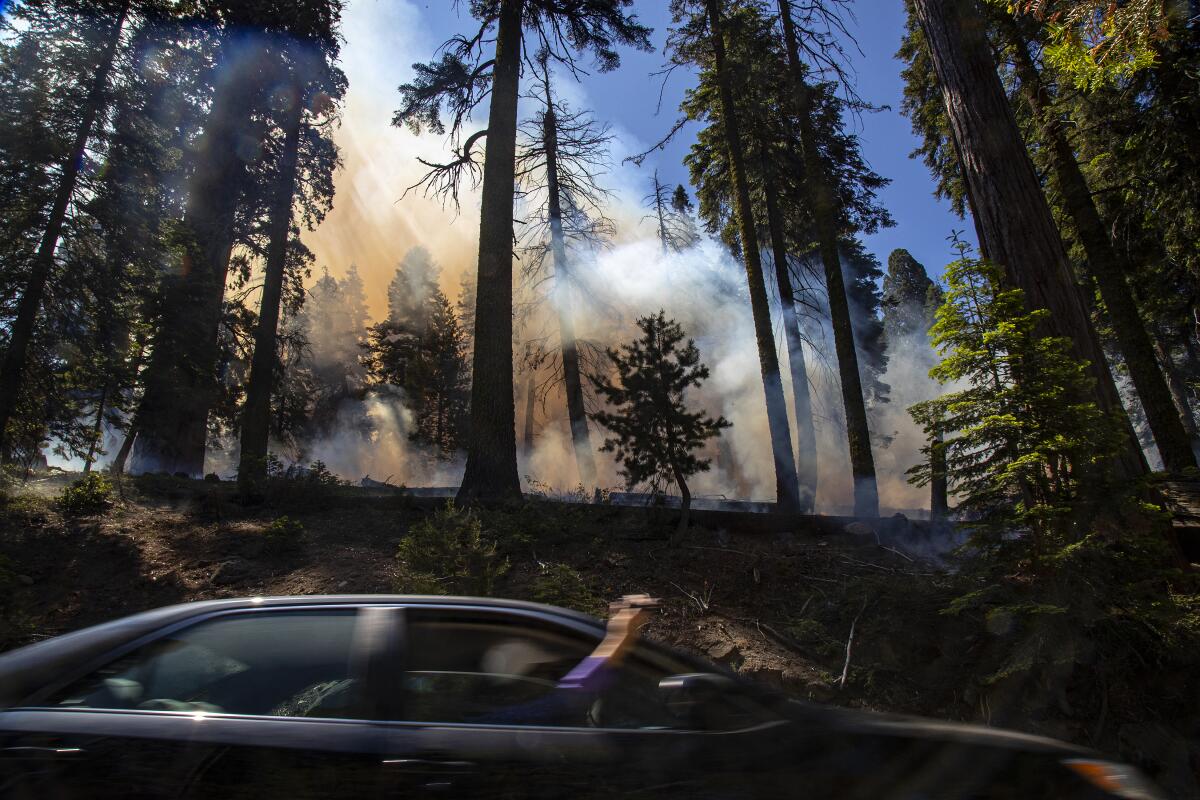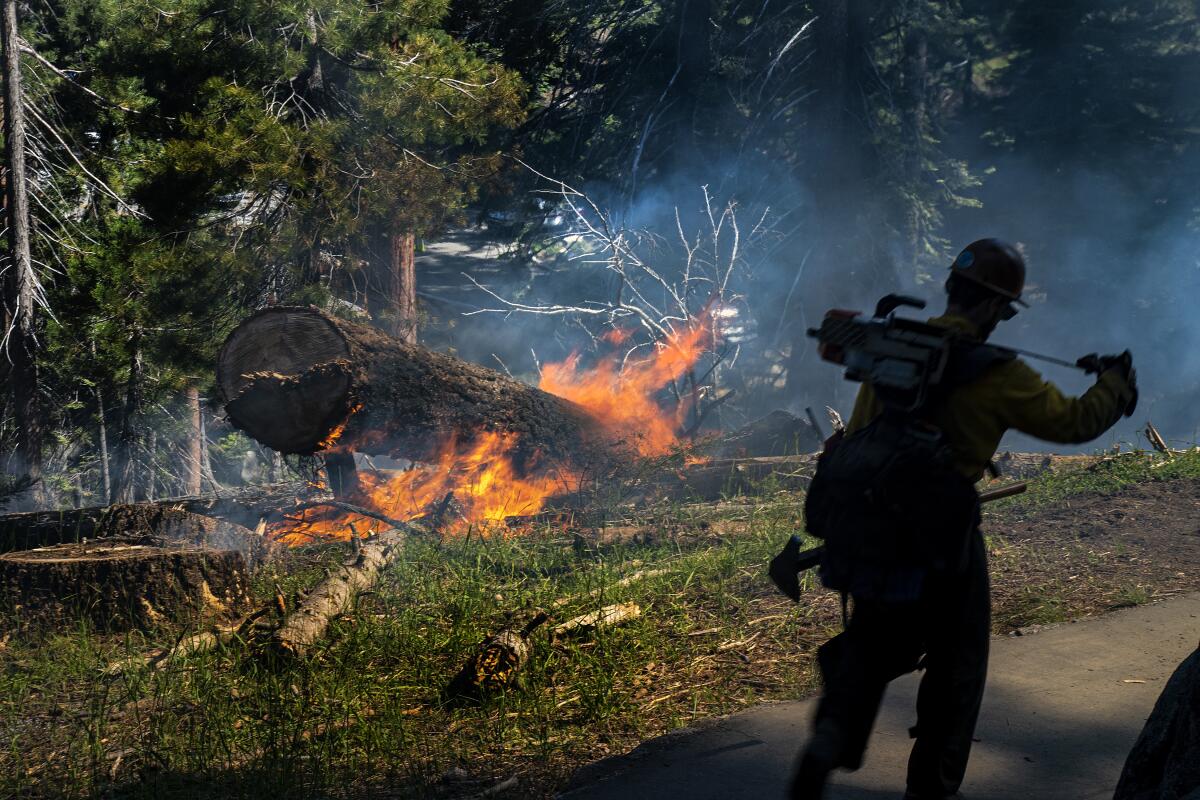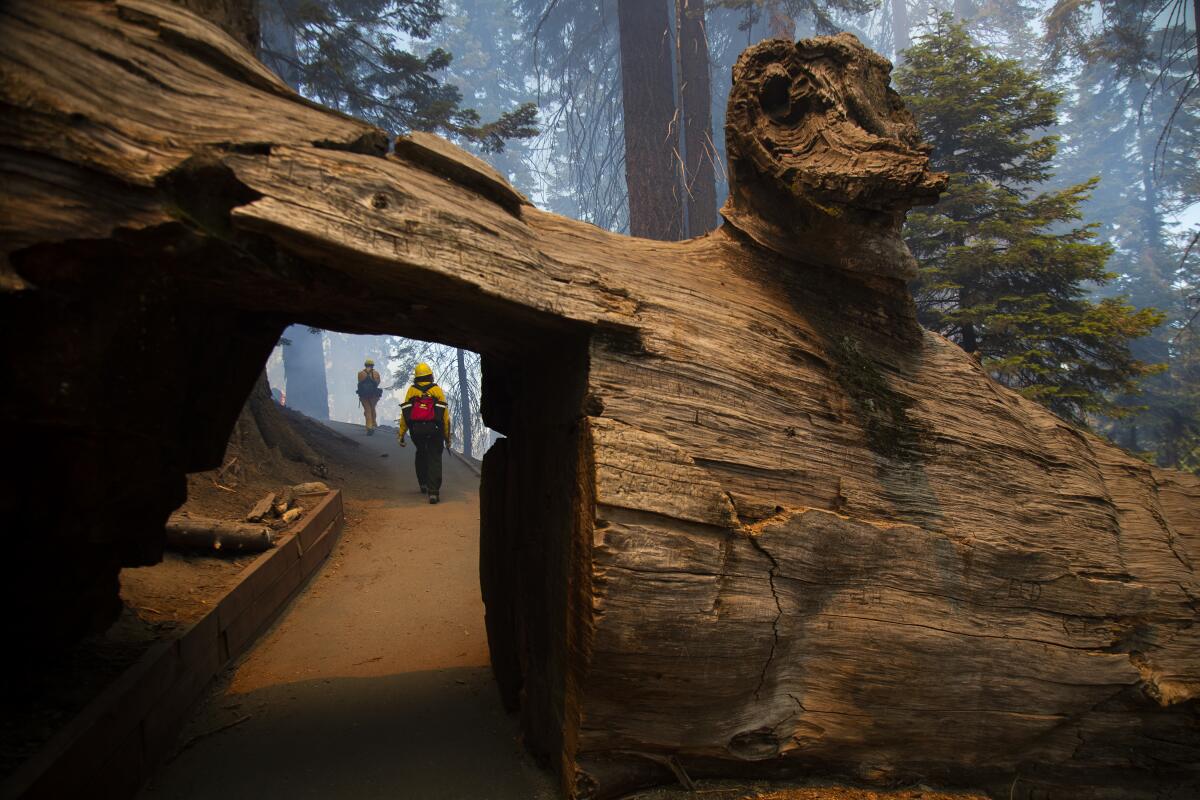California fire mystery: No major summer brush fires after years of record destruction

- Share via
Sequoia National Park, Calif. — Gawking tourists hung halfway out their car windows, cameras aimed at firefighters and flames along the shoulder of Generals Highway.
Typically by this point in the summer, fire officials are dealing with multiple blazes across California, including ones that brush up against this area of Sequoia park. But so far things have been remarkably calm — giving firefighters time to prepare with prescribed burns and offering a respite, however brief.
After two years of devastating wildfires that burnedmore than 1.8-million acres in 2018 and 1.2-million acres in 2017, as of Sunday only 51,079 acres have burned this year across state and federal lands in California.
Late spring rains, cooler summer temperatures and fewer extreme wind events, among other factors, have combined to help keep the state from burning uncontrollably, experts say.
But weary fire officials know that can change at any moment — all it takes is an intense wind event or a prolonged heat wave and then a spark.

A year ago at this time, California was on fire.
The largest blaze in state history — the Mendocino Complex fire — was roaring through Lake County. A monster fire was taking aim at Lake Elsinore. And in Redding, hundreds of residential lots were in rubble from a blaze that made a deadly march into city subdivisions, with a “fire tornado” adding to the the destruction.
Conditions this summer have been much more tame.
In Redding, there have been 30 days where the temperatures have hit or exceeded 100 degrees. Last year it was 43, the National Weather Service said.
In Ukiah, site of the Mendocino Complex fire, there have been nine days of temperatures reaching or exceeding 100 degrees. Last year it as 22.
In Southern California, counties across the region are experiencing the coolest average summer temperatures since 2011.
At the same time, all three of the state’s biggest utilities say they have seen fewer extreme wind conditions that would trigger a preventative shutdown of their power lines this year compared with 2018. Winds are the biggest wild card with fires: Major red-flag events are a key factor in fires that rage out of control.
California has seen exceptionally quiet fire years before, all of them before the seven-year drought that officially ended in March. In 2010, about 110,000 acres of California burned statewide, followed by 126,000 the year after.
In 2017, it was generally quiet until late into the fire season. Then wine country fires that October destroyed thousands of homes and killed dozens of people, followed by the devastating Thomas fire in Santa Barbara and Ventura counties in December.
“First responders are preparing, and the public needs to do that too,” said Mike Mohler, spokesman for the California Department of Forestry and Fire Protection. “We don’t want to cry wolf, but we want people to be on heightened alert.… We have not let our guard down.”
Firefighters say they are using the quiet time to prepare.
Following two years of unprecedented destruction, Gov. Gavin Newsom and the state Natural Resources Agency fast-tracked dozens of projects for 2019 to bulldoze, dig and chop fuel breaks surrounding communities and escape routes considered at high risk for wildfire.
Thinner vegetation means a less-intense fire, which gives firefighters the chance to make a defensive stand.
In 2015, the Rough fire spread to Sequoia and Kings Canyon national parks but was stopped in its tracks when it hit a section of Giant Forest where for decades park officials had conducted prescribed burns.
Setting fires in order to clear the forest floor can be done only when the resulting smoke won’t pose a health hazard, the winds won’t push the flames too fast and the fuels aren’t too dry or too moist — allowing the fire to move at a steady, predictable pace.
Once the floor is cleared and the fire has opened up space in the canopy for light to break through, tiny sequoia cones no bigger than the palm of your hand will dry out from the flames’ heat and burst open. The expectation is that some of those seeds will fall onto open, fertile soil and germinate, establishing the next generation of 3,000-year-old behemoths.
For more than two years, however, poor weather conditions forced the cancellation of more prescribed burns in that area.
But in early July the conditions were just right — to the delight of park officials, firefighters and the public.
Over four days, firefighters set ablaze 238 acres in the western Sierra, a cathedral of giant sequoias that includes the world’s biggest tree, the General Sherman.
While the park swelled with tourists, hikers, bikers and climbers, dozens of firefighters meticulously worked nearby — torching trees, duff covering the soil and jackpots of fuel made up of logs, dead leaves and brush.
“It’s kind of cool to be able to do this in July, it’s different,” federal firefighter Ed Fulton said as he fed foot after foot of hose to a colleague monitoring his section of the fire.
When done effectively, a forest fire gives sequoias a leg up over some other trees vying for space.
At a certain age, sequoias are resilient enough to survive a moderate fire. They have thick, hollow bark that provides a layer of protection, small seed cones that release their payload under extreme heat and branches high from the forest floor so that flames have no ladder to climb to the top.
But until that point, trees like the white fir have the advantage, said National Park Service fire ecologist Tony Caprio. White fir trees can grow in the shade and even faster in sunlight, giving them an early chance to elbow out young sequoias, which desperately need the light to thrive.
During the burn’s first day on July 8, while dozens of firefighters hiked through the grove above Generals Highway — hidden in a smokey veil — Fulton was on the highway shoulder next to his bright red rig, looking for burning timber that could roll onto the highway and stop traffic.
“If anything does roll out, we can cool it down and mop it up so it’s not a threat,” Fulton said.

Prescribed burns also have been taking place in other parts of the state, along with efforts to thin dense shrublands and reinforce fuel breaks.
“What we could consider fall- and spring-months projects we’ve been able to do through July, which for every agency is a benefit toward the forest’s health,” said Mohler of Cal Fire.
But the danger still looms, experts warn.
In its wildfire seasonal outlook released Aug. 1, the National Interagency Fire Center said the grass sprouted from this past winter had produced an “abundant crop” of fuel to burn when Santa Ana and Diablo winds return to the state in the fall and winter.
If rainfall is scarce come October when all that grass has cured, the lower half of the state will be vulnerable, the agency warned. Fortunately for the northern half of California, a massive snowpack has left much of the state at average risk of fire.
More to Read
Sign up for Essential California
The most important California stories and recommendations in your inbox every morning.
You may occasionally receive promotional content from the Los Angeles Times.










